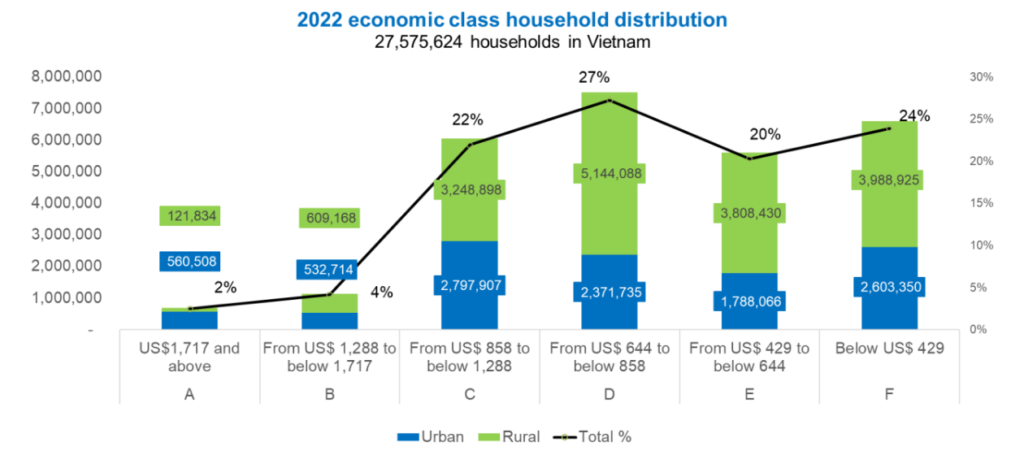
In Vietnam, consumer trends are evolving rapidly, driven by factors such as a growing working-age population, GDP growth, increased manufacturing, and changing consumer attitudes. This report, conducted by Cimigo Vietnam, delves into the consumer trends that will shape the Vietnamese market in 2023. From the preferences of different demographic groups to the rise of digital transformation and financial ecosystems, this article explores the key factors influencing customer satisfaction and consumption patterns in Vietnam.
Working Age Population and Low Dependency Ratio:
With a working population comprising 62% of the total population in 2022, Vietnam boasts a significant labor force. Half of the working population falls within the 20 to 39 age group, with a high participation rate among females aged 20 to 64. This demographic advantage contributes to a low dependency ratio, with just 0.7 dependents per employed person. The working population’s multiple sources of income and disposable income create opportunities in sectors such as travel, fashion, and beauty services. Additionally, the silver generation’s focus on health and increased leisure time in retirement opens avenues for wellness-related industries.
GDP Growth and Economic Performance:

Over the past ten years, Vietnam has maintained an average GDP growth rate of 5.9%. In 2022, the economic performance improved compared to the previous year, but certain factors, including consumer price inflation, rising borrowing costs, and energy cost inflation, posed threats to growth in the final quarter of the year.
Manufacturing Gains and Global Trade Interconnectivity:

Vietnam leads the global charts in terms of trade interconnectivity. The country’s global interconnectivity reached 180% in 2022, indicating strong participation in international trade. Although manufacturing experienced a slowdown in the fourth quarter of 2022, growth resumed in February 2023, showcasing the sector’s resilience and ongoing development.
Retail Goods and Services Consumption:
Consumer demand for retail goods and services remains robust, accounting for 55% of Vietnam’s GDP. Modern trade, including supermarkets and shopping malls, represented 26% of retail goods sales in 2022. However, online shopping is rapidly gaining traction and is projected to surpass modern trade’s share of sales by 2028.
Domestic Tourism:
The COVID-19 pandemic severely impacted international tourism, resulting in sluggish growth compared to pre-pandemic levels. As a result, domestic tourism has emerged as a vital contributor to the industry, filling the void left by international visitors.
Internet Economy and Digital Transformation:
Vietnam’s internet economy reached a value of US$23 billion in 2022. With widespread digital access, the country is experiencing transformation, innovation, and enhanced digital experiences. The digital society and media landscape are bridging the urban-rural divide, bringing the global worldview to a broader population.
Rising Household Affluence:
Vietnam is witnessing a rise in household affluence, with 15,386,852 households falling into the ABCD economic class, indicating an income above US$644 (VND 15,000,000) per month. This trend is accompanied by smaller, wealthier households due to migration and lower birth rates.
Financial Ecosystems and E-commerce:
In 2022, 70% of Vietnamese adults had access to banking services, signifying a high level of financial inclusion. Digital transformation is reshaping retail banking, while e-wallets have achieved significant penetration across both urban and rural areas. Cash on delivery remains the dominant payment method for online shopping, followed by bank transfers. Momo leads the market with a 51% share, closely followed by ShopeePay.
In conclusion, the consumer trends in Vietnam for 2023 reflect a dynamic and rapidly changing market.
Key Point Summary:
- Significant working-age population and high labor participation
- Consistent GDP growth, despite challenges
- Vietnam’s manufacturing sector excelling in global trade interconnectivity
- Robust consumer demand, with a shift towards online shopping
- Domestic tourism compensating for the decline in international tourism
- Rapid expansion of the internet economy and digital transformation
- Rising household affluence and changing demographics
- Financial ecosystems enabling e-commerce and e-payment solutions
To leverage the opportunities presented by these consumer trends and receive personalized support, please contact our dedicated team in Vietnam. We are here to assist you in navigating the dynamic Vietnamese consumer landscape.

Leave a Reply